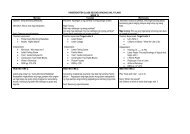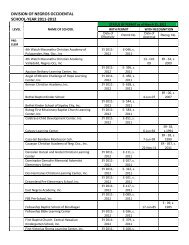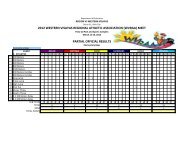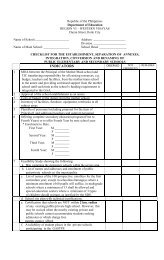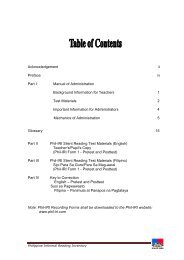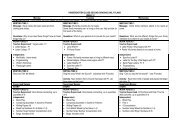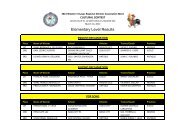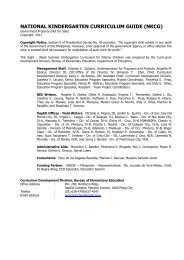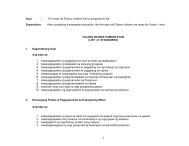5s 6s AM Class Fourth Quarter Daily Plans (sample)
5s 6s AM Class Fourth Quarter Daily Plans (sample)
5s 6s AM Class Fourth Quarter Daily Plans (sample)
Create successful ePaper yourself
Turn your PDF publications into a flip-book with our unique Google optimized e-Paper software.
KINDERGARTEN CLASS SECOND GRADING DAILY PLANS<br />
WEEK 20: ____________________<br />
Monday Tuesday Wednesday<br />
CONTENT FOCUS: Family members have different responsibilities at home. Families set their own rules.<br />
MEETING TIME 1:<br />
Message:<br />
Parents and older siblings earn a living for the family<br />
MEETING TIME 1:<br />
Message: Sometimes other family members help their<br />
parents with their jobs.<br />
Question:<br />
Who earns a living for your family ?<br />
What kind of work do they do ?<br />
Ex. children help their parents in their farm or cook food to sell<br />
Question: Do you or your siblings help your parents with their<br />
job ?<br />
WORK PERIOD 1 WORK PERIOD 1 WORK PERIOD 1<br />
Teacher-Supervised: Target Letter : Rr<br />
Teacher-Supervised: Fieldtrip to a place of work of a parent<br />
Poster: People Earn a Living in Different Ways<br />
MEETING TIME 1:<br />
.<br />
Message: People earn a living in different ways.<br />
Some people earn a living by making and selling goods.<br />
Question: Who makes and sells goods in your<br />
community ?<br />
Independent:<br />
Independent:<br />
Letter Collage : Rr<br />
<br />
<br />
Letter for the Day<br />
Sound- O<br />
Independent:<br />
Letter Mosaic<br />
Spin a Word<br />
Letter for the Day<br />
Making a trip chart<br />
Sand Play<br />
Sound O<br />
Finger Painting<br />
Writer’s Workshop<br />
Spin a word<br />
Writer’s Workshop<br />
Finger Painting<br />
Block Play<br />
MEETING TIME 2: MEETING TIME 2: MEETING TIME 2:<br />
Message:<br />
Show the family mobiles to the class. Ask the children<br />
what sort of things do we learn from our families.<br />
Questions:<br />
Message:<br />
<br />
Invite a few children to talk about the work that<br />
their parents and older siblings do.<br />
Teacher-Supervised:<br />
Poster: At the _________ (place of work of the parent)<br />
Big Book: People do different jobs .<br />
Let’s Write Rr<br />
Questions:<br />
Supervised Recess Supervised Recess Supervised Recess<br />
STORY:<br />
Si HInlalaki<br />
STORY:<br />
Si Monica Dalosdalos<br />
STORY:<br />
Gusto ko ng Pansit Ngayon<br />
WORK PERIOD 2: WORK PERIOD 2: WORK PERIOD 2:<br />
Teacher-Supervised: Descriptions<br />
Teacher-Supervised: Subtraction Cards (writing number<br />
sentences)<br />
Teacher-Supervised: Subtraction Cards (writing number<br />
sentences)<br />
Independent:<br />
Block Play<br />
Bingo: Addition/ Bingo: Subtraction (0-6)<br />
Independent:<br />
Block Play<br />
Bingo: Addition/ Bingo: Subtraction (0-6)<br />
Independent:<br />
Block Play<br />
Bingo: Addition/ Bingo: Subtraction (0-6)
6 Concentration/ Find 6<br />
Roll and Count (up to quantities of 6)<br />
INDOOR/OUTDOOR ACTIVITY:<br />
Face to Face<br />
SONGS/RHYMES:<br />
Mag-anak (PEHT, p. 153)<br />
Masayang Pamilya (PEHT p. 154<br />
6 Concentration/ Find 6<br />
Roll and Count (up to quantities of 6)<br />
Writing Numerals (0, 1, 2, 3, 4, 5, 6)<br />
INDOOR/OUTDOOR ACTIVITY: Snake Tag<br />
SONGS/RHYMES:<br />
Heto na si Ina (PEHT p. 15)<br />
Si Kuya (PEHT p. 154)<br />
Draw 6/Go 6<br />
Roll and Count (up to quantities of 6)<br />
Writing Numerals (0, 1, 2, 3, 4, 5, 6)<br />
INDOOR/OUTDOOR ACTIVITY: Cat and Mouse Trap<br />
SONGS/RHYMES:<br />
Si Kuya (PEHT p. 154)<br />
Masayang Pamilya (PEHT p. 154)<br />
MEETING TIME 3: Dismissal Routine MEETING TIME 3: Dismissal Routine MEETING TIME 3: Dismissal Routine
THURSDAY FRIDAY NOTES<br />
MEETING TIME 1: People earn a living in different ways<br />
Some people earn a living by giving services.<br />
MEETING TIME 1:<br />
Message: Families set their own rules<br />
Questions:<br />
What rules do you follow at home ?<br />
How do these rules help your family?<br />
WORK PERIOD 1 WORK PERIOD 1<br />
Teacher-Supervised: Target Letter : Dd<br />
Letter Poster: Dd<br />
Puppets: People Who Do Things for Others/ People<br />
Who Make or Sell things<br />
Teacher-Supervised: Let’s Write Dd<br />
Literature-based Activity : Picture Walk<br />
Independent:<br />
Our Rules At Home<br />
Independent:<br />
Letter for the Day :Dd<br />
Sight Words Trace<br />
Letter Domino<br />
Letter-Making<br />
Literature-based Activity: Accordion Book<br />
Letter Collage : Dd<br />
Sand Play<br />
Words Poster: Letter D<br />
Writer’s Workshop<br />
Sand Play<br />
MEETING TIME 2: MEETING TIME 2:<br />
Talk about household chores at home. Let them share Ask some children to share rules that they follow at home.<br />
about responsibilities at home.<br />
Compare some of these rules with those that they follow in<br />
school. How do these rules help them?<br />
STORY:<br />
Ang Tikbalang Kung Kabilugan ng Buwa<br />
Teacher-Supervised: Pattern Block/ Card Patterns<br />
Independent:<br />
Block Play<br />
Bingo: Addition/ Bingo: Subtraction (0-6)<br />
Draw 6/Go 6<br />
Roll and Count (up to quantities of 6)<br />
Writing Numerals (0, 1, 2, 3, 4, 5, 6)<br />
INDOOR/OUTDOOR ACTIVITY:Snake Tag<br />
SONGS/RHYMES:<br />
Si Neneng PEHT p. 154)<br />
MEETING TIME 3: Dismissal Routine<br />
STORY:<br />
Sina Dosal at Makopoy sa Paanan ng Bundok Pinatubo<br />
Teacher-Supervised: Train Ride<br />
Balloons<br />
Independent:<br />
Block Play<br />
Pattern Block/Card Designs<br />
Subtraction Cards (writing number sentences)<br />
6 Concentration/ Find 6/ Draw 6/Go 6<br />
Roll and Count (up to quantities of 6)<br />
INDOOR/OUTDOOR ACTIVITY: Leap frogs<br />
Roll the ball Through The Tunnel<br />
SONGS/RHYMES:<br />
Magtanim ay Di Biro<br />
MEETING TIME 3: Dismissal Routine
APPENDIX: Week 20<br />
A. THEME RELATED ACTIVITIES<br />
Poster: People Earn a Living in Different Ways<br />
Materials: manila paper, crayons/colored marker, glue, magazines<br />
Number of players/participants: 6-8<br />
Procedure:<br />
1. Have children cut-out pictures of people earning a living.<br />
2. Paste these pictures on manila paper or kraft paper.<br />
3. Have children label each picture or drawing.<br />
Note: if there are no magazines available, have children draw instead.<br />
Trip Chart:<br />
Family Mobiles: What I learned from my family<br />
Materials: yarn , colored shape cut-out mounted on cardboard, puncher,<br />
Number of players/participants: 6-8<br />
Procedure:<br />
1. Have children draw things they have learned from particular family members.<br />
2. Let them label their drawings.<br />
3. Punch a hole on top of the shape card. Tie a yarn through it and hang on a hanger.<br />
4. Write the title “ Things I learned from my family” on a strip of paper and tape it into the handle of the hanger<br />
Puppets: People Who Do Things for Others/ People Who Make or Sell things<br />
Materials: mineral water bottles, scrap cloth, glue, scissors<br />
Number of players/participants: 4-6<br />
Procedure:<br />
1. Have children make puppets of community helpers using junk materials.<br />
2. Let them write or draw what each community helper does for others.<br />
Poster: At the (work place of parent)<br />
Materials: manila paper, crayons/ colored markers<br />
Number of players/participants: 6-8<br />
Procedure:<br />
1. Ask children to recall what they saw at the workplace of the parent.<br />
2. Have them draw things they saw there, other people who work there and what<br />
they do.<br />
3. Have them share this poster with the rest of the class<br />
Shape Poster: Our Rules At Home<br />
Materials: house cut-outs (bond paper or construction paper), crayons/colored markers, pencils<br />
Number of participants: 10-12<br />
Procedure: Have children draw or write rules their families have at home<br />
B. OTHER LANGUAGE ARTS ACTIVITIES<br />
Letter Collage, Letter Mosaic, Word Poster Letter Collage, Spot the Letter, Letter Poster ( refer to Week 11<br />
appendix)<br />
Letter Making<br />
Objective/Competency: letter formation<br />
Materials/Preparation: cardboard, glue, buttons or beans<br />
On separate piece of cardboard, draw each letter of the alphabet and outline them in block style. Use numbers<br />
and arrows to show the letters are formed.<br />
Procedure:<br />
1. Distribute letter cards to each child.<br />
2. Let each child place beans or buttons within the outline of each block letter.<br />
3. Have them use the arrows and numbers as a guide for forming the letters in writing.<br />
4. Have them run their finger over the beans or buttons and verbalize the movements they<br />
are making to form the letter. For example, for the capital L, they would say “down, across.”
Literature-based Activity : Picture Walk<br />
Materials/.preparation:<br />
Storybook for the day<br />
picture Walk sheet<br />
Crayons or markers<br />
Number of Players/participants: 6-8<br />
Procedures:<br />
1. Write the title and author.<br />
2. Think about how to retell the story in pictures.<br />
3. Decide on three key events. They should retell the beginning,<br />
middle, and ending.<br />
4. Draw a picture for each event in the order they happened.<br />
Sight Words Trace<br />
Objectives: trace sight words<br />
Materials: pencil, sight word cards mounted on cardboard<br />
Number of players/participants: any number<br />
Procedure:<br />
1. Give each child a worksheet with several sightwords.<br />
2. Have the child trace these words with her pencil.<br />
Letter Domino: Upper/ Lower Case Letters<br />
Objective: to identify upper case letters<br />
Material : 24pcs upper case letter domino cards<br />
Number of players/participant: 5-6<br />
Procedure:<br />
1. Deal all cards to the players.<br />
2. The first player lays down a card.<br />
3. The next player lays down a card that can be connected to either letter on the card that s been previously laid<br />
down<br />
4. Game continues until all cards have been laid down<br />
Sound- O<br />
Objective/Competency: Letter sound correspondence<br />
Materials: cardboard, picture cards<br />
Preparation: Divide the cardboard into 26 sections and write a different letter of the<br />
alphabet on each. Prepare 26 picture cards(each showing an item beginning with a different<br />
letter). Write the name of the object on the back of its card and underline its initial letter. For<br />
example, if the card has a picture of a dog on it, write the word dog on the back and
underline the letter d.<br />
Procedure:<br />
1. First player picks up a picture card, say the name of the object aloud and place it on the letter that corresponds<br />
to the initial sound of the object.<br />
2. Continue until all the letters on the gameboard are covered.<br />
3. Remove the cards, checking each one against the word on the back.<br />
Spin a Word<br />
Objectives: recognize sight words<br />
Materials: sightwords printed on the spinner board, individual sight word chart, pencil<br />
Preparation:<br />
1. Make a spinner board with a set of sight words<br />
2. Write a chart containing the same sight words on the spinner board<br />
Number of players/participants: 4-6<br />
Procedure:<br />
1. Distribute a sight word chart and pencil to each player.<br />
2. Each child takes turns using the spinner. At each turn, the child reads the sight word that he lands on.<br />
3. Then he marks this off on the chart.<br />
4. The first person to mark off all the words on his chart is the winner.<br />
Literature-based Activity: Accordion Book<br />
A. OTHER MATH ACTIVITIES<br />
Descriptions<br />
Assemble the children and ask for a volunteer. This child stands apart from the group so everyone can see him or her.<br />
The class describes the child by naming visual attributes, they sit down until the volunteer is the only child left standing.<br />
The teacher writes the attributes on cards as each is mentioned.<br />
Teacher: Everyone stand up. What can you tell me about our volunteer?<br />
Children: She's a girl.<br />
The teacher writes<br />
a girl<br />
Teacher: Anyone fitting the description can remain standing. Anyone who doesn't fit it must sit<br />
down. What else can you tell me to write down about our volunteer?<br />
Children: She's got long hair.<br />
The teacher writes<br />
long hair<br />
Block Play<br />
Objective: to explore the attributes of 3-dimensional or space figures<br />
to understand the relationship between figures<br />
to build structures using blocks<br />
Materials: table or floor blocks<br />
No. of Participants: 1-4<br />
Procedure:<br />
Children use table or floor blocks to build structures.<br />
While building structures children are encouraged to talk about attributes of block (e.g. long/ short, heavy/light)<br />
and the relationship of each block to another (e.g. 2 of these blocks make 1 of these blocks)<br />
Children can also be encouraged to build structures based on the theme of the week (e.g. building homes,<br />
schools, establishments in the community)<br />
Writing Numerals (0,1, 2, 3, 4, 5, 6)<br />
Objective: to write numerals<br />
Materials: lined paper (blue-red-blue lines) numeral cards<br />
Preparation: Draw the numerals on a piece of card board. The first part of the numeral is drawn with the purple<br />
crayon and the second part with green. The purple and green marks will help children determine which stroke to<br />
do first.
1. Provide each child with numeral cards and lined paper.<br />
2. Let each child practice writing the numerals on lined paper.<br />
Draw 6<br />
Objective : to explore different combinations that make 6<br />
Materials : 4 sets of numeral cards (0 –6)<br />
No. of players / participants: 3- 5 players<br />
Procedure<br />
1. One card is drawn from the deck and is set aside throughout the game, so that there will be an odd card without<br />
a mate at the end of the game. All the other cards are dealt.<br />
2. Each player goes through the cards received trying to find pairs that make 6. All the pairs thus made are<br />
discarded in the middle of the table.<br />
3. The players then take turns, each holding her cards like a fan and letting the person to her left draw one of them<br />
without looking at them. If the person who draws the card can use it to make 6 with one of the cards in her hand,<br />
she discards the pair in the middle of the table. If she cannot use it, she has to keep it. She then holds all her<br />
cards like a fan so that the person to her left can draw one of them by chance.<br />
4. Play continues until one person is left holding the odd card and loses the game.<br />
6 Concentration<br />
Objective: to explore different combinations that make 6<br />
Materials: 4 sets of numeral cards (0-6)<br />
Procedure:<br />
1. Sixteen cards are placed in the middle of the table, face down, in a 4 x 4 arrangement. The remaining cards are<br />
placed faced-down in a stack.<br />
2. The players take turns turning over two cards, trying to turn a pair that totals 6. If a pair can be made, the player<br />
keeps it and continues to play as long as he is successful. If he is not successful, he returns the two cards to<br />
their original face-down positions and replaces any cards he took with new ones from the deck.<br />
3. With 16 face-down cards on the table, the turn passes to the next player to the left.<br />
4. The person who collects the greatest number of pairs is the winner.<br />
Find 6<br />
Objective:<br />
Materials : 4 sets of numeral cards (0-6)<br />
No. of players / participants : 3-5 players<br />
Procedure<br />
1. All cards are dealt. Last card is turned face up. Each player keeps the cards dealt to him in a stack, face-down,<br />
without looking at them.<br />
2. By turns, players turn over the top card of his stack. If this card can be used with one on the table to make a<br />
total of 6, the player can take it and keep the pair. If there are no cards that can be used, he has to discard his<br />
card in the middle of the table, face up.<br />
3. The player who collects the most number of pairs wins.<br />
Go 6<br />
Objective: to explore different combinations that make 6<br />
Materials: 4 sets of numeral cards (0-6)<br />
Procedure:<br />
1. All the cards are dealt.<br />
2. The players take turns asking specific people for specific cards in a way similar to the card game Go Fish. For<br />
example, John may say to Carol do you have a 1 ?" If Carol has a 1, she has to give it up to John. John then<br />
lays this 1 and a 5 in front of himself, face up.<br />
A player can continue asking for a card as long as he gets the card he requested. If he does not get the card he<br />
asked for, the turn passes to the person who said, "I don't have it."<br />
3. The person who makes the greatest number of pairs is the winner.<br />
Subtraction Cards (writing number sentences)<br />
Objective: to subtract quantities up to 6<br />
Materials: subtraction cards, counters<br />
No. of Participants: 1-4<br />
Procedure:<br />
1. Teacher reads the total on the card, in this case 6.<br />
2. Children get 3 counters.
3. Teacher says "take away one" while lifting the right hand flip.<br />
4. Children take away 1 counter, count remaining counters and say "five"<br />
5. Teacher shows the group the five remaining dots on the subtraction card.<br />
Bingo: Addition (up to quantities of 6)<br />
Objective: To match an addition fact with its correct sum<br />
Materials: bingo card for each player calling cards tokens<br />
No. of Participants: 1-4<br />
Procedure:<br />
1. Provide each player with a bingo card.<br />
2. Assign a student to call out what is written on calling cards.<br />
3. First one to cover all spaces wins. If players go through all the cards without reaching Bingo, they should<br />
reshuffle the cards, then turn them face down again and continue playing until someone has won.<br />
Bingo: Subtraction (up to quantities of 6)<br />
Objective: To practice subtraction up to quantities of 6<br />
Materials: bingo card for each player calling cards tokens<br />
No. of Participants: 1-4<br />
Procedure:<br />
1. Provide each player with a bingo card.<br />
2. Assign a student to call out what is written on calling cards.<br />
3. First one to cover all spaces wins. If players go through all the cards without reaching Bingo, they should<br />
reshuffle the cards, then turn them face down again and continue playing until someone has won.<br />
Roll and Count<br />
Objective: to compare quantities<br />
Number of participants: 2-4 players<br />
Materials: plus and minus spinners die<br />
Newsprint or bond paper for each child<br />
clothespins<br />
Procedure:<br />
1. The children take turns rolling the die and turning the spinner.<br />
2. Each child adds or subtracts clothespin from his or her working space paper according to the die and spinner.<br />
3. If the spinner and die indicate they are to take away more clothespins than they have on their papers, the<br />
children say “impossible” and spin again.<br />
4. If they are to add more clothespins than they have room for on their working space papers, they each get an<br />
additional paper.<br />
Train Ride<br />
Objectives: to add and subtract single-digit numbers<br />
Players: small or whole group<br />
Materials: chalk and chalkboard<br />
Procedure:<br />
1. Divide the group into 2<br />
2. The first player in each group goes to the chalkboard and draws a train engine. As directed the leader writes a<br />
numeral, for example 8, on the drawing of the train.<br />
3. The second player then comes up to draw a coach, on which he writes a combination that names the number<br />
selected for the engine, such as 4 + 2.<br />
4. Continue in order until a member of the group thinks that all combinations have been shown.<br />
5. The team whose train shows all combinations for the engine number wins.<br />
Balloons<br />
Concept: Addition-Subtraction<br />
Objectives: to add and subtract single-digit numbers<br />
Players: individual, small or whole group<br />
Materials: chalk and chalkboard<br />
Procedure:<br />
1. Draw pictures of balloons on the chalkboard and write an addition or subtraction combination on each.
2. Players take turns by trying to “pop the balloons” by giving answers to the combinations. Children may indicate<br />
the popping of balloons by clapping hands<br />
Variation: Instead of drawing balloons, flowers, leaves and other more familiar objects can be drawn.<br />
Pattern Block or Cards Designs<br />
Objectives: to explore relationships of shapes<br />
Players: individual, pair or small group<br />
Materials: pattern blocks or cards<br />
Allow children to explore the properties of pattern blocks or pattern cards by creating their own designs. Pairs of<br />
children can work together – one child creates a design that his or her partner reproduces<br />
During exploration children can be asked a variety of questions that will help them think about the geometric<br />
properties of the blocks/ cards and about the relationship between shapes<br />
Which shapes fit together with no shapes in between?<br />
Which shapes fit together to make this shape?<br />
How many triangles would you need to fill up this shape?<br />
During exploration you may also comment about specific shapes or designs:<br />
I notice here you made a little rectangle and then you made another twice as big.<br />
If I drew a line here, it would look the same on both sides. That’s because it is symmetrical.<br />
B. SONGS/POEMS/ RHYMES<br />
C. INDOOR/OUTDOOR G<strong>AM</strong>ES<br />
Cat and Mouse Trap<br />
Five people are chosen to be the trap and they form a circle by holding hands with arms raised over their heads<br />
One person is chosen to be the cat who starts by facing away from the trap, not looking at it (perhaps with eyes closed).<br />
The remaining players are all mice.<br />
The game begins with the mice walking in and out of the trap simultaneously. The cat waits for the right moment then<br />
suddenly turns back around and shouts “ snap!” at which point the trap brings its arms down and captures whoever is in<br />
the circle. The captured mice becomes part of the trap. The game continues until all but one mouse is caught. He is<br />
declared the winner<br />
Face to Face<br />
Each player is assigned a partner by the leader. The leader may play music and begin calling out instructions as to how<br />
the partners may face each other. For example, if he calls out “face to face” they stand opposite each other, looking at<br />
each other. He can call out things such as side to side, back to back, elbow to elbow, thumb to thumb, right hand to left<br />
hand. At some point he stops the music or calls out (if no music is used), “Everyone changes partners! “ The person left<br />
without a partner is the new leader who calls out the directions. As the game goes one, it can be more challenging if the<br />
rule is that each person must find a partner he has not had before.<br />
Leapfrogs<br />
Directions:<br />
1. Have children form a line.<br />
2. Let them crouch down as if they are playing leapfrog.<br />
3. Sing the following song to the tune of “ London Bridge is Falling Down “<br />
4. The child in the song should be the last child in the row.<br />
5. When the child hears his name, he holds onto the shoulders of the child in front of him and leaps. After each<br />
leap, the children call out a number. When he reaches the front of the line, the game begins again
Song:<br />
We are hopping, hopping frogs,<br />
Hopping frogs, hopping frogs.<br />
We are hopping, hopping frogs,<br />
Here hops [name of child]!<br />
Snake Chase<br />
Direction:<br />
1. This game starts out like a regular game of tag.<br />
2. When the first child is tagged, the two children join together to make a “snake,” and the snake runs after the<br />
remaining children.<br />
3. Each child who is tagged becomes part of the snake.<br />
Roll the Ball Through the Tunnel<br />
Direction:<br />
1. Stand with your legs spread wide.<br />
2. Challenge the student to roll the ball through the “tunnel” that is formed.<br />
3. As they becomes better and better at this, stand farther away and see if they can still succeed.<br />
Variation: Set up several tunnels so that the child rolls the ball through multiple tunnels with the adults standing<br />
in a line so that theirlegs line up.<br />
STORIES<br />
Si Monica Dalosdalos<br />
Mga Tanaong sa simula ng kuwento<br />
1. Sino sa inyo ang maagang gumising sa umaga?<br />
2. .Tumutulong ba kayo sa bahay ?<br />
3. Ano ang paborito niyong gawaing bahay ?<br />
Mga tanong pagkatapos ng kuwento<br />
1. Sino ang pinaguusapan sa ating kwento?<br />
2. Anong ginagawa ni Monica Dalosdalos paggising niya sa umaga?<br />
3. Anong nagustuhan niyo sa mga ginawa ni Monica Dalosdalos?<br />
4. Ano ang hindi niyo nagustuhan sa kanyang mga ginawa?<br />
5. Saan nangyari ang kwento?<br />
6. Ano ang mangyayari kapag hindi nag-iingat sa mga gawaing bahay ?<br />
7. Ano ang mga pag-iingat na kailangang gawin pag ginagawa ang mga gawaing bahay ?<br />
Si Hinlalaki<br />
( Pagkasama , Laging Okey)<br />
Aklat Adarna<br />
Sa limang anak ni Inang Kamay,<br />
Si Hintuturo ang panganay.<br />
At dahil mahilig magturo<br />
Kaya laging guro sa paglalaro.<br />
Kung may hinahanap o naliligaw,<br />
Si Hintuturo din ang pinagtatanungan.<br />
Si Hinlalato naman ang pinakamatangkad<br />
Kaya sa larong basketbol ay sikat.<br />
Pinakamalakas pa sa sumping<br />
Kaya laging pinakamagaling.<br />
Ang pustoryosong si Palasingsingan,<br />
Siya naming taga- ingat ng yaman.
At ang bunsong si kalingkingan<br />
Ang masipag nilang utos- utusan;<br />
Kahit tinutuksong “ Hinliliit!”<br />
Bawat butas nililinis.<br />
Pero itong si Hinlalaki<br />
Ang walang titak na silbi<br />
Kaya sa laro ay di kasali<br />
At palaging nasa tabi – tabi.<br />
Dahil punggok at iba ang tabas,<br />
Tinutukso pang” Anak sa labas”.<br />
Minsan ang lakas ni Hinlalato<br />
Sa pagbubuhat ng poste ay napasubo.<br />
Tumulong ang tatlong kapatid<br />
At naligo na silang apat sa pawis;<br />
Pero ang poste’y di matinag- tinag<br />
At talaga yatang pagkabigat – bigat!<br />
Sumaklolo si Hinalalaki.....<br />
At biglang gumaan ang poste!<br />
Kaya ngayon, sinasabi:<br />
“ Walang mabigat na poste, Pagkatulong si Hinlalaki”.<br />
Questions before reading:<br />
1. Ilan ang ating daliri?<br />
2. Alin si Hinlalaki?<br />
3. Gusto ba ninyong malaman ang mga katangian ni hinlalaki mula sa kwento?<br />
During Reading?<br />
1. Sino ang panganay sa limang magkakapatid?<br />
2. Sino ang bunso?<br />
3. Ano ang tawag kay hinlalaki?<br />
4. Sino ang makapaglalarawan kay Hinlalaki?<br />
After Reading:<br />
1. Sino ang tinulungan i Hinlalaki?, Paano?<br />
2. Dapat banating tularan si Hinlalaki?, Bakit?<br />
Sina Dosal at Makopoy<br />
Sa Paanan ng Bundok Pinatubo<br />
Mga Tanaong sa simula ng kuwento<br />
1. Sino na sa inyo ang nakaakyat ng bundok?<br />
2. Ano ang nakikita sa bundok?<br />
Mga tanong pagkatapos ng kuwento<br />
1. Sino ang mga tauhan sa kwento?<br />
2. Ano ang nagustuhan niyong ginagawa nila Dosal at Makopoy?<br />
3. Ano ang hindi niyo gusto sa kanilang mga ginagawa?<br />
4. Saan nangyari ang kwento?<br />
5. Ano ang makikita niyo sa lugar na pinangyarihan ng kwento?<br />
6. Ano ang inyong maririnig sa pinangyarihan ng kwento?<br />
7. Bakit lumipat sina Dosal at Makopoy nang tirahan?<br />
8. Ano ang nangyari sa lugar nila kung bakit lumipat sila nang tirahan?<br />
9. Kujng kayo si Dosal at Makopoy lilipat din ba kayo ng tirahan pagkatapos nang pagsabog ng Pinatubo? Bakit?<br />
Ang Tikbalang Kung Kabilugan ng Buwan<br />
Mga tanong pagkatapos basahin ang kwento:
1. Sino ang mga pangunahing tauhan sa kuwento?<br />
2. Anong bahagi ng kuwento ang nagustuhan mo at bakit?<br />
3. Ano ang naramdaman nang tikbalang kapag may kalaro siya tuwing kabilugan ng buwan?<br />
4. Saan nangyari ang kuwento?<br />
5. Bakit nalungkot ang tikbalang?<br />
6. Ano ang nakapagpasaya sa tikbalang?<br />
7. Kung ikaw ang tikbalang at wala kang kalaro, ano ang gagawin mo?<br />
Gusto ko ng Pansit Ngayon<br />
Mga tanong sa simula ng kwento:<br />
1. Sino sa inyo ang mahilig sa pansit?<br />
2. Naranasan niyo bang pagsawaan ang paborito niyong pagkain?Bakit?<br />
3. Anong nalaman ni Diding nang pinatulong siya sa paghanda ng pagkain?<br />
4. Kayo rin ba ay tumutulong sa paghahanda ng pagkain sa bahay?<br />
Mga tanong pagkataapos magbasa ng kwento:<br />
1. Sino ang pangunahing tauhan sa ating kwento?<br />
2. Anong nagustuhan niyo sa ginawa ni Diding?<br />
3. Ano ang pagbabagong nangyari kay Diding nang malaman niyang pinag-iisipan pala ang paghanda ng<br />
pagkain?<br />
4. Bakit ayaw na kainin ni Diding ang mga paborito niyang pagkain?<br />
5. Ano ang ginawa ng Tatay at Nanay ni Diding upang hindi na maging mapili siya sa pagkain?<br />
Sampung Magkakaibigan<br />
Mga tanong sa simula ng kuwento:<br />
1. Marami ka bang kaibigan ?<br />
2. Sino sa sampung magkakaibigan ang katulad sa ugali niyo?<br />
3. Naranasan niyo na bang hindi isali sa laro ng inyong mga kaibigan?<br />
4. Ano ang inyong naramdaman?



